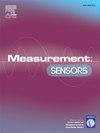同轴探头端部采用金属腔,以确定材料的介电常数和耗散系数
Q4 Engineering
引用次数: 0
摘要
本文提出了一种基于集总和分布元件与被测样品(SUT)相结合的新型宽带技术,该技术被困在五边封闭铜腔的孔内,并由扁平端接SMA(开放式同轴探头)馈电,以确定介电常数(DK)和耗散因子(DF)。该方法新颖地表达了有效介电常数和相对介电常数之间的关系,通过一个二阶多项式函数与三个未知的复系数,每个复系数依赖于一个特定的频率。该技术仅利用特定范围内的标准材料DK来确定所需的系数,包括探针-腔界面效应。这是为了在DK上达到高于5%的预期精度。该方法提供了提取高达10−4 DF的可能性。SUT为正方形,边长4.1 mm,厚度510 μm。利用与矢量网络分析仪(VNA)射频设备相关的测量平台,在0.24-18.0 GHz频率范围内对熔融石英和99.5%氧化铝进行了测试。所有测量都在两种配置下进行:空腔(捕获装置)充满真空(作为参考),然后是SUT(待表征样品)。本文章由计算机程序翻译,如有差异,请以英文原文为准。
Coaxial probe ended by a metallic cavity cell to determine the material dielectric constant and dissipation factor
– A new broadband technique based on combining the lumped and distributed elements with the sample under test (SUT) trapped inside the hole of the five-side-closed copper cavity and fed by a flat termination SMA (open-coaxial probe) is developed to determine the dielectric constant (DK) and dissipation factor (DF) and described in this paper. The method novelty expresses the relationship between the effective and relative permittivities through a second-degree polynomial function with three unknown complex coefficients, each of which is dependent on a specific frequency. The technique utilizes only the standard materials DK within a particular range to determine the required coefficients, including probe-cavity interface effects. That's for reaching an expected accuracy better than 5 % on the DK. The method offers the possibility of extracting up to DF. The SUT is a square with a side length of 4.1 mm and a thickness of 510 μm. The Fused Quartz and Alumina 99.5 % have been tested in the 0.24–18.0 GHz frequency range, utilizing the measurement bench associated with the vector network analyzer (VNA) radiofrequency equipment. All measurements are made in two configurations: the cavity (trapping device) is filled with vacuum (as a reference), followed by the SUT (sample to be characterized).
求助全文
通过发布文献求助,成功后即可免费获取论文全文。
去求助
来源期刊

Measurement Sensors
Engineering-Industrial and Manufacturing Engineering
CiteScore
3.10
自引率
0.00%
发文量
184
审稿时长
56 days
 求助内容:
求助内容: 应助结果提醒方式:
应助结果提醒方式:


